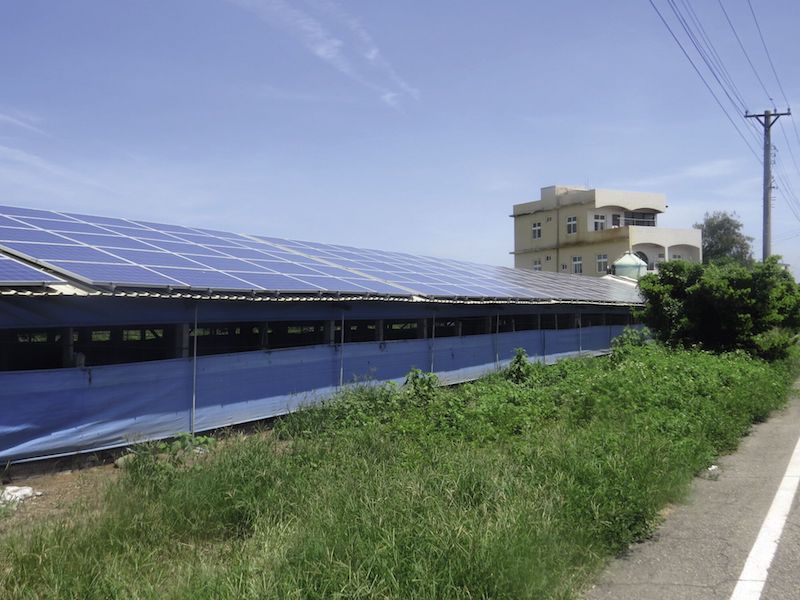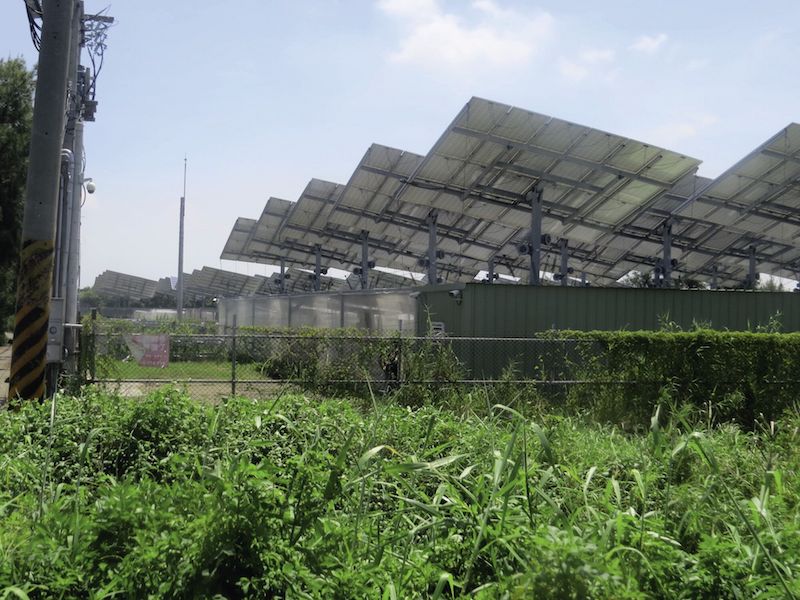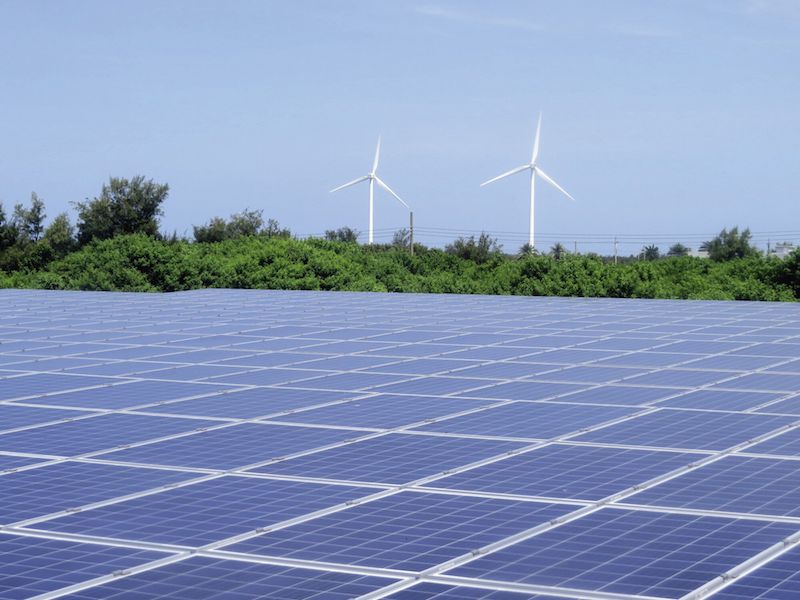In Taiwan’s rural Yunlin County, traditionally one of the island’s least developed areas, solar power installers were once met with suspicion by the region’s mostly elderly farmers, most of whom were wary of this alien technology and the urbane salespeople pushing it. After years of outreach, however, “they love us here now,” says Slash Chiu, Sales Director for local EPC installer Sinogreenergy.
Sinogreenergy is one of Taiwan’s largest solar power developers, with more than 70 MW of installed solar capacity in its portfolio, most of it rural rooftop applications. Farmers now embrace the effortless rental income they earn from solar power producers such as Sinogreenergy and others for solar installations placed on their barn roofs, and compete for the right to host solar power installations.
Taiwan has ramped up its rooftop solar installations with an attractive feed-in tariff (FIT) of NT$4.40 (US$0.15) per kilowatt hour. This has led to something of a boom in Yunlin, as well as Chiayi, Changhua, and several other counties in Taiwan’s underdeveloped center and southern regions.
Taiwan’s government plans on seeing 20 GW of installed solar PV capacity on the island by 2025, and most will be installed in these sunnier, mostly rural counties. Already, PV investors and developers are making big plans for Taiwan’s solar market, including international private equity firm Equis Fund, which just announced that Taiwan’s Bureau of Energy (BOE) has approved its 70.2 MW solar project in Chiayi County’s Yizhu Township.
“We are very excited about this project in Taiwan, especially for a project of this size, as it’s going to be the largest development of its size for the country,” said Equis Fund Communications Director Roberto Devido. “We are moving ahead with all of the next steps, which includes the permitting and the selection of the EPC contractor. Once those things are in place we put a shovel in the earth and we start working, and that will be Q4 2017 or Q1 2018. We expect to be delivering power by the end of 2018.”
Meanwhile, local solar manufacturer Motech recently announced more tentative plans for 400 MW in Taiwan’s southernmost county, Pingtung.
While nearly all of Taiwan’s current 1.4 GW of installed solar is on rooftops, solar developers recognize that if Taiwan is ever to reach its solar power goals, it needs to ramp up ground-mounted installations, particularly in the central and southern counties. These counties enjoy some of the highest insolation levels in Taiwan and have the most available land. But they are also the breadbasket of Taiwan.
Delicate balance
Taiwan is a small island of some 35,000 square kilometers, two thirds of it steep mountains that rise to nearly 4,000 meters, and hence off-limits to large-scale development. Taiwan’s 23 million people live mostly in densely populated cities on the western plain, which is also where most of Taiwan’s arable land is. An installed solar capacity of 20 GW would likely require 20,000-25,000 hectares of land – nearly 3% of Taiwan’s total of 800,000 hectares of arable land.
Taiwan’s Council of Agriculture (COA) has been reluctant to release agricultural lands to solar power development for fear of risking Taiwan’s food supply and agricultural sector.
This is the essential challenge that Taiwan’s domestic solar providers must face, and largely explains why Taiwan’s domestic installations still lag, despite having a president and legislature firmly in support of Taiwan’s energy transformation. The market has definitely picked up, as can be seen in Yunlin, but it has developed far more slowly than expected, and Taiwan is little more than 400 MW a year into its interim goal of an additional 1.54 GW by the summer of 2018 (on top of the previous 900 MW that had been installed as of mid-2016). The government is aiming for “rooftop installations generating 910 MW of power and surface installations generating 610 MW” by July 2018, according to the website of the Executive Yuan.
“The available land is quite limited in Taiwan and there are many arguments over how best to utilize the space, so progress has been slow,” says TY Lin, Senior Manager for AUO Solar, a division of AU Optronics. AUO Solar has 500 MW of module making capacity split between Taiwan and China, and also builds and operates solar power capacity in Taiwan and abroad under the brand Sungen. Sungen currently manages 25 MW of solar power capacity in Taiwan, all of it on rooftops. Despite weekly announcements of plans for vast new installations, not a single large-scale ground-mounted project has actually been completed, less even approved.
Export woes
While domestic installations are slow to pick up, Taiwan’s export solar manufacturing sector is struggling. Taiwan’s smaller capacity and shrinking tech advantage put the industry at a disadvantage in scale and costs compared to the juggernaut of the Chinese market, with its massive manufacturing capacity and record demand of 24.4 GW installed in the first half of 2017 alone. Energy Trend is forecasting 48 GW for the year in China – nearly half of the total global market of 100 GW. The country has rendered Taiwan’s 11 GW of cell manufacturing capacity as little more than spare capacity for its module makers – an OEM situation that developed first when Chinese cells were slapped with antidumping tariffs from the U.S., but which has continued to thrive even after Taiwan was also subject to tariffs. Now, the cells provided to Chinese makers often end up consumed in China’s vast market.
For most of the year, despite strong demand from China, Taiwan’s cell makers were operating at losses, and only recently have positive numbers returned. Cell makers were unable to pass on higher costs due to high wafer prices, and so most sold at prices below cost.

Motech, Taiwan’s largest solar PV maker, reported first half 2017 revenue of NT$10.667 billion (US$354 million), a 42% decline in annual comparisons, while NeoSolar Power (NSP) fared even worse, reporting first half net revenue of NT$4.381 billion (US$144.5 million), a 57.9% year-on-year decline. Gintech Energy Corporation earned NT$6.597 billion (US$219 million) in the first half of 2017, a 30% decline. “Cell ASPs have experienced a deep drop since last July mainly due to the expiration of subsidy from China,” Motech noted in email correspondence, stating that cell ASPs hovered around US$0.22-23/W, comparing to US$0.30+/W in the first half of 2016. “That’s why you see a substantial reduction in both sales and revenues this year.”
“Our selling price is restricted by the China market,” says Jason Tsai, an analyst for Energy Trend, explaining that Taiwan lacks sufficient local wafer making capacity so it needs to import wafers, mostly from China, as well as lacking module making capacity, so it needs to sell back to China.
Motech intends to optimize profitability by promoting higher efficiency products with a higher premium, and most of Taiwan’s manufacturers emphasize the higher efficiency and quality of domestically made solar cells. But analysts warn that Chinese solar manufacturing capability has largely bridged the technology gap, and that Taiwanese makers are currently only several months ahead of their rivals across the Taiwan Strait – instead of several years.
Much of the technology gap can be closed simply through the purchase and utilization of the most advanced manufacturing equipment, and with Chinese firms’ deep pockets and support from the government, this is something Chinese firms can do more easily than Taiwanese firms.
The U.S. Commerce department has already reduced the antidumping (AD) and countervailing (CV) tariffs against Taiwanese makers, imposed in 2012 and 2014, and most of Taiwan’s solar manufacturers have invested in third-party capacity for the U.S. market. According to Energy Trend’s Tsai, Taiwanese cells used in non-Chinese made modules would be subject to AD/CV duties in the U.S. ranging from 3.56%-4.2%, while Taiwanese cells used in Chinese-made solar modules would be taxed at much higher rates of 21.8%-31.37%. Demand from the U.S. is actually exceeding this third-party capacity and Energy Trend estimates around 800 MW of Taiwan-made solar cells ended up in modules shipped to the U.S. market.
Local demand
With the playing field angled against them, solar cell makers hope that domestic demand will pick up the slack, particularly as Taiwan’s smaller geography, good FIT rates, and harsh weather all invite the installation of higher quality, high output solar modules, which Taiwan specializes in. Taiwan has gone large-scale into high efficiency PERC technology and the government offers a 6% increase in FITs for “high performance” panels, although according to Energy Trend, it hasn’t strictly defined “high performance.”
TY Lin says that after five years in Taiwan’s rooftop solar makers market, AUO Solar has gleaned a number of important insights into building systems that can survive in Taiwan’s harsh subtropical environment. “During those five years, we have experienced several typhoons and we have the data from both good and bad experiences, so we know how to make anti-typhoon modules.” He adds that as Taiwan is an island, corrosion from high humidity and saltwater is another problem that the company has built into its panels. AUO offers high performance back contact 330 W rated solar modules that are corrosion resistant and sturdy enough to withstand severe typhoons. “This is value added, compared to the cost of replacement and to the downtime and power drop – so it works,” says Lin.
With less than 10% of Taiwan’s goal of 20 GW by 2025 so far achieved. Taiwan will need to install more than 18 GW in the next seven years – more than 2 GW a year, a booming market that would favor local producers.
To get the ground-mounted installations market rolling, the COA has released 803 hectares of land that has subsided due to overuse of groundwater, has been encroached on by seawater, or is otherwise no longer viable for agriculture, in Chiayi and Tainan cities in the south of Taiwan, while other areas of Yunlin and Changhua are also under consideration. The release of the land is to stimulate investment totaling NT$91.2 billion (US$2.9 billion).
Ecological factors are also being taken into consideration, and Equis Fund’s Devido said that “there was quite a strong request that there be ecological considerations factored into the bid,” adding that Equis included ecological measures to ensure the preservation of wetlands and an environmental education component into its successful bid.
Yet skepticism lingers, with projects routinely delayed due to administrative hurdles, and the BOE’s approval of a project is only the first of many hoops to jump through, including passing environmental muster with the Environmental Protection Administration, as well as gaining the approval of the COA.

Image_3_opt
Yet, the Equis Fund is confident that its project – and many other ground-mounted projects – will be approved.
“Taiwan is at a moment in time when it badly needs renewable energy,” says Devido. “The government is behind this and they are interested in seeing it succeed.”
Author : Tim Ferry
This content is protected by copyright and may not be reused. If you want to cooperate with us and would like to reuse some of our content, please contact: editors@pv-magazine.com.
